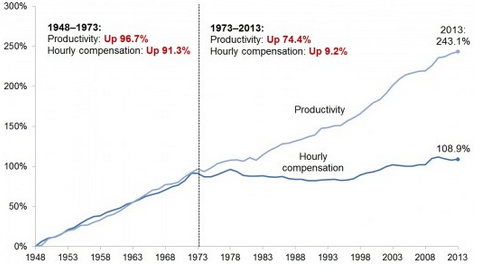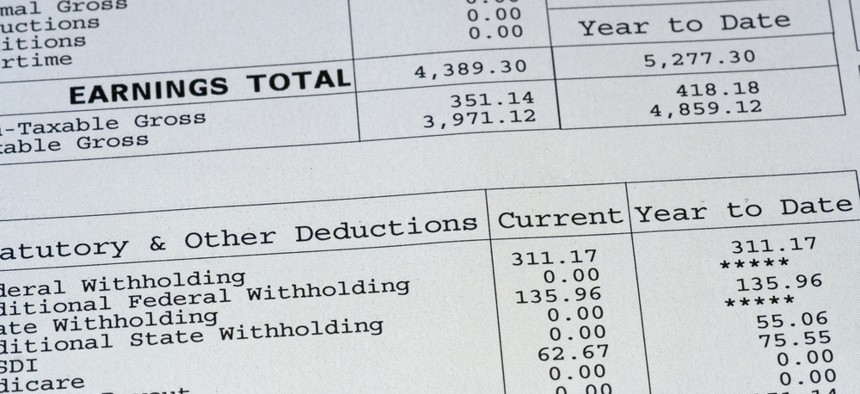Why the Gap Between Worker Pay and Productivity Is So Problematic
Labor has become more efficient and profitable, but employees aren't sharing in the benefits.
One of the most frustrating parts of the sluggish recovery has been paltry wage gains for most workers. The stock market may be booming, corporate profits increasing, and home values rising, but middle and lower-class workers often don't truly feel the benefit of such improvements unless wages rise.
But wage stagnation isn't just a problem borne of the financial crisis. When you look at the relationship between worker wages and worker productivity, there's a significant and, many believe, problematic, gap that has arisen in the past several decades. Though productivity (defined as the output of goods and services per hours worked) grew by about 74 percent between 1973 and 2013, compensation for workers grew at a much slower rate of only 9 percent during the same time period, according to data from the Economic Policy Institute .
Productivity vs. Compensation

Economic Policy Institute
I spoke with Jan W. Rivkin, an economist and senior-associate dean for research at Harvard Business School who studies labor markets and U.S. competitivenessin order to learn more about the history of the gap, and what it means for workers and the broader economy. The interview that follows has been lightly edited and condensed for clarity.
Gillian White: So how long has the gap between wages and worker productivity persisted, and what does it mean for workers, other than the fact that they aren't seeing significant wage gains?
Jan Rivkin: From the end of WWII until the 1970s productivity in the U.S. and median wages grew in lockstep. But from the late 1970s until today we've seen a divergence, with productivity growing faster than wages. The divergence indicates that companies and the people who own and run them are doing much better than the people who work at the companies.
If the U.S. economy was healthy and competitive, we'd see firms able to do two things: win in the global marketplace and lift the living standards of the average American. Large businesses and the people who run them, and invest in them, are thriving but working and middle-class Americans are struggling—as are many small businesses.
White: Some say that the decrease of collective bargaining has played a role in creating the gap, how true do you think that is?
Rivkin: There are a number of causes, one is the underlying shift in technology and globalization. Another is systematic underinvestment in the commons, which is a set of shared resources that every business needs in order to be productive: an educated populace, pools of skilled labor, a vibrant network of suppliers, strong infrastructure, basic R&D and so on. A third is shifts in institutions and politics and bargaining power, which is embodied in the decline in collective bargaining and the weakening of labor unions. There's no question that that is part of the story. How large a part? I don't think anyone has a well-informed perspective.
White: Ok, so let’s talk more about some of the principle reasons this gap developed and then started to widen.
Rivkin: Starting in the 1980s changes in geopolitics and technology opened the world for business. It became possible to do business from anywhere and to automate an increasing array of activities. Globalization and technological change brought great benefits to the U.S. economy, but it had a few other consequences.
White: For instance?
Rivkin: It weakened the connections between companies and their communities. Those connections had led companies to invest in the commons, so corporate investment in the commons starts to decline around that period. Second, it put intense pressure on the middle class, which found itself competing for jobs with hundreds of millions of skilled, ambitious workers around the world—so this is the point at which we see the divergence between productivity growth and median-wage growth.
A third consequence occurred at the other end of the skills spectrum. For those who had unique skills, this became a golden age because now those individuals were able to sell their talents around the world, amplified by technology. So this is when we see inequality begin to soar.
White: This gap, like lots of other forms of inequality seems to bear down on the middle class—why do you think that is?
Rivkin: We could have doubled down on making the middle class so capable that it could compete with anyone, but I think instead, what we did collectively is we made a series of unsustainable promises to maintain the illusion of prosperity. Promises like: let's extend credit to the middle class so that people can consume—especially houses; promises like the government will increasingly cover your healthcare costs in retirement, promises like the government will directly employ you. You then take those promises, couple them with a nasty recession and two wars and you wind up with a government that is physically hobbled and politically divided. So from government and from business you've got a systematic underinvestment in those shared resources that we need for the middle class to thrive.
White: You’ve said before, this isn’t just a middle-class issue, it impacts everyone and has ramifications for the economy as a whole. So how does this issue stretch beyond middle-class workers?
Rivkin: The divergence that I described is not just a problem for the middle class, it's a problem for all of society. Without a strong middle class we see weak consumption. With unhappy workers we have a less productive set of people for business to hire. If we're only tapping the creativity and potential of a small fraction of our population that can't be good for society. If working, middle-class Americans are not thriving, eventually they become anti-business voters. So this should be a concern for the 1 percent not only ethically, but economically.
White: Is there a way to rectify the situation, to close the gap or at least create better outcomes for workers?
Rivkin: There are some forces at work that are unstoppable and we probably wouldn’t want to stop them even if we could. Forces of globalization, technological change—those genies are out of the bottle. But there are other parts of they dynamic that are purely choice. The damage done by underinvestment is a self-inflicted wound.
We need a movement toward cross-sector collaboration for rebuilding the commons and for sharing prosperity. We're seeing multiple examples of businesses that have realized that it’s in their interest to make sure that their workers are well educated, are skilled, that their supply networks are healthy, that the infrastructure in the cities where they operate is strong.
Investing in the commons should not be a substitute for raising wages, but wages are determined in a competitive market. It's impossible, for a company to justify paying an employee more if that employee hasn't been appropriately productive for the company. I think that business leaders just need to recognize that companies can't thrive for long if their communities are struggling.
White: Do you think that actual changes in business and policies that could help the situation are feasible in this environment?
Rivkin: It is a tricky moment. I really see us at a crossroads with two pathways. The current path is one where federal policy makers squabble for partisan gains, delay tough choices, and make America a less attractive place to compete. Business leaders pursue their narrow short-term interest and free ride off each other's investments—the business environment deteriorates, businesses leave America, the government enacts anti-business policies, companies reduce their U.S. activities further, and distrust deepens.
There is however another, far-better path possible. Federal policy makers put their long-term fiscal house in order, invest in infrastructure, enact policies that make America a great place to do business. Business leaders recognizing their long-run interest is in a vibrant commons take steps to build a skilled workforce, to upgrade local suppliers, to foster innovation, to reinforce education. The productivity gains enable firms in the U.S. to win in the global market place while also creating jobs that lift living standards. And then with robust growth, government and business gather the resources to reinvest in making the business environment better and better over time.
The first steps down that attractive path are fairly clear, the key question is: Can Americans muster the will, the foresight, and the unity to take the steps to head down that path?
( Image via Josh randall / Shutterstock.com )
NEXT STORY: How Not to Kill Employee Engagement



